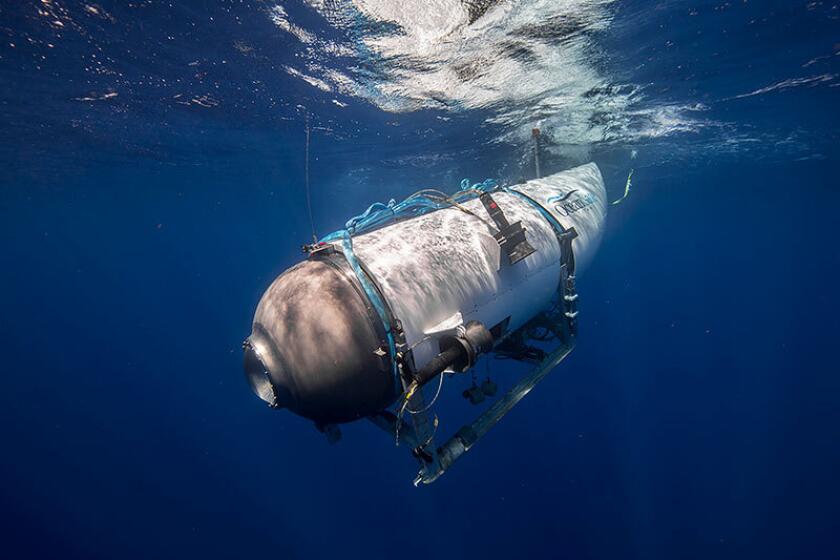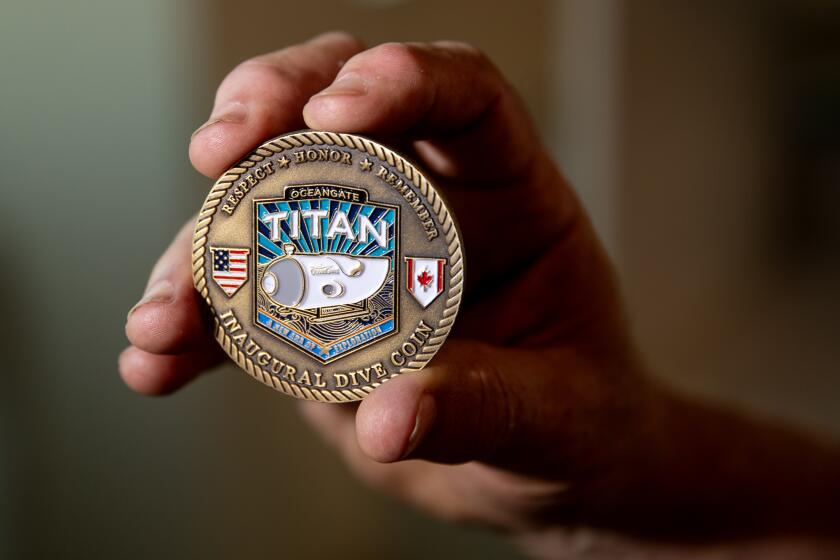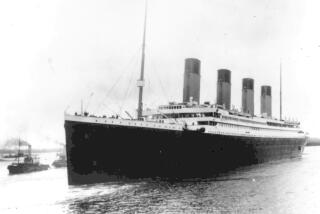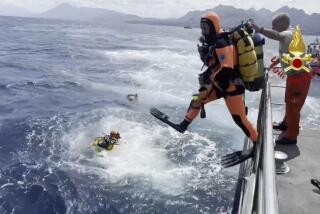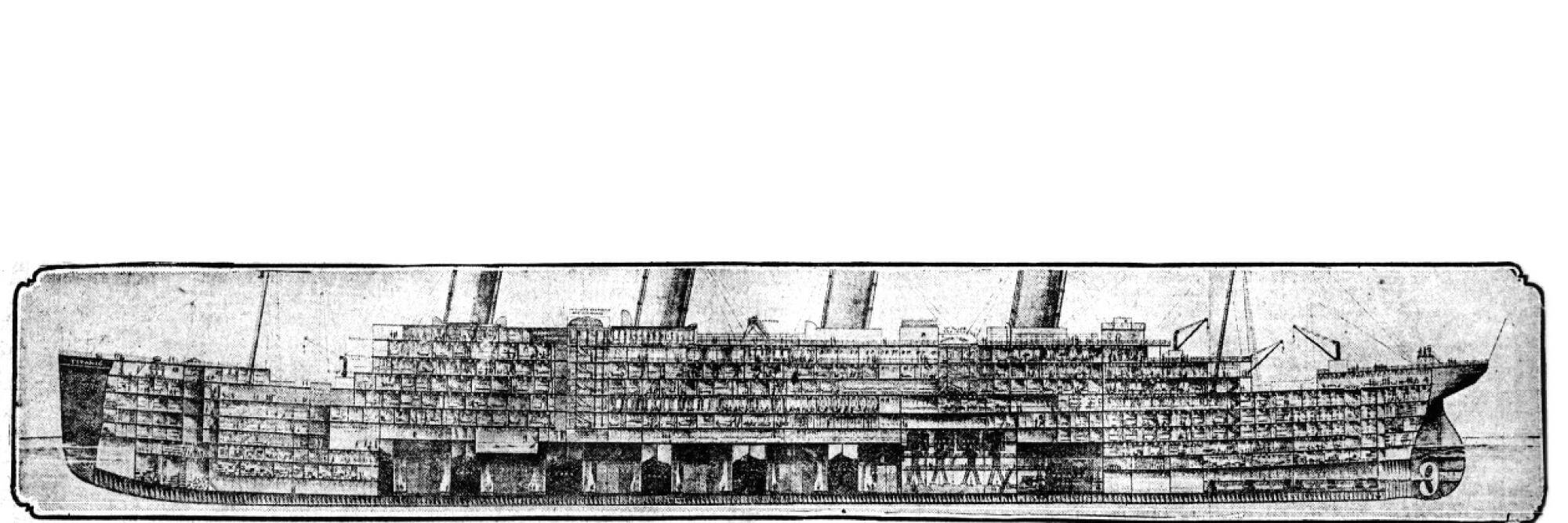
On April 16, 1912, the Los Angeles Times front page chronicled what it called “the greatest marine disaster in the history of the world” — the sinking of the Titanic.
The breaking news coverage touched on several themes: the loss of life, the worsening chances for survivors being found, the safety of the vessel and the immense personal fortunes of those on board. Parallels to contemporary news coverage of the submersible that suffered a “catastrophic implosion” on its voyage to the Titanic shipwreck site are apparent.
Its scope and presentation reflect newspaper styles of that era, combining a detailed and at times repetitious report with numerous illustrations and sidebars topped with stacks of subheadlines.
The Times is republishing the coverage in full, with changes only to capitalization and punctuation for ease of readability. The coverage can also be read in The Times’ archive in its original format.
Fifteen hundred lives lost when Titanic plunges headlong into depths of the sea
- Men of world-wide prominence go down with ship after women and children are taken off in lifeboats
- Only six hundred and seventy-five people saved out of total of twenty-two hundred on board ill-fated vessel
- Newest and greatest liner in the world, built at cost of ten million dollars and embodying latest scientific principles, sinks as quickly as wooden fishing smack after collision with iceberg off coast of Newfoundland.
By direct wire to The Times
NEW YORK, April 13 — [Exclusive dispatch] The greatest marine disaster in the history of the world occurred last Sunday night when the Titanic, of the White Star Line, the biggest and finest of steamships, shattered herself against an iceberg and sank with 1,500 of her passengers and crew in less than four hours.
Out of nearly 2,200 persons that she carried only 673 were saved and most of these are women and children. They were picked up from small boats by Cunarder Carapthia which found, when she ended her desperate race against time, a sea strewn with wreckage of the lost ship and bodies of drowned men and women.
Not a name of those saved had reached the offices of the White Star line or the Cunard line at midnight, though every effort was being made to get in communication with the vessel that bore the survivors. It is probable that these names will be received in the morning. All night a crowd of anxious relatives and friends of the Titanic’s passengers were massed in front of the line’s offices at No. 9 Broadway.
There were 325 first cabin passengers on the Titanic, of whom 128 were women and 15 children. In second cabin there were 285 persons, including 79 women and 8 children, and in the steerage the complement of 710 was divided almost equally, it is believed, between women and men, with a small percentage of children.
The numbers are enough to indicate that if the women and children were saved, very few men could have survived the disaster, as there were almost enough women and children aboard to make up the 675 survivors. The crew numbered 860, bringing the total of those known to be aboard up to 2,180, but it is understood that at the last minute before sailing several got aboard, making the total up to a full 2,200.
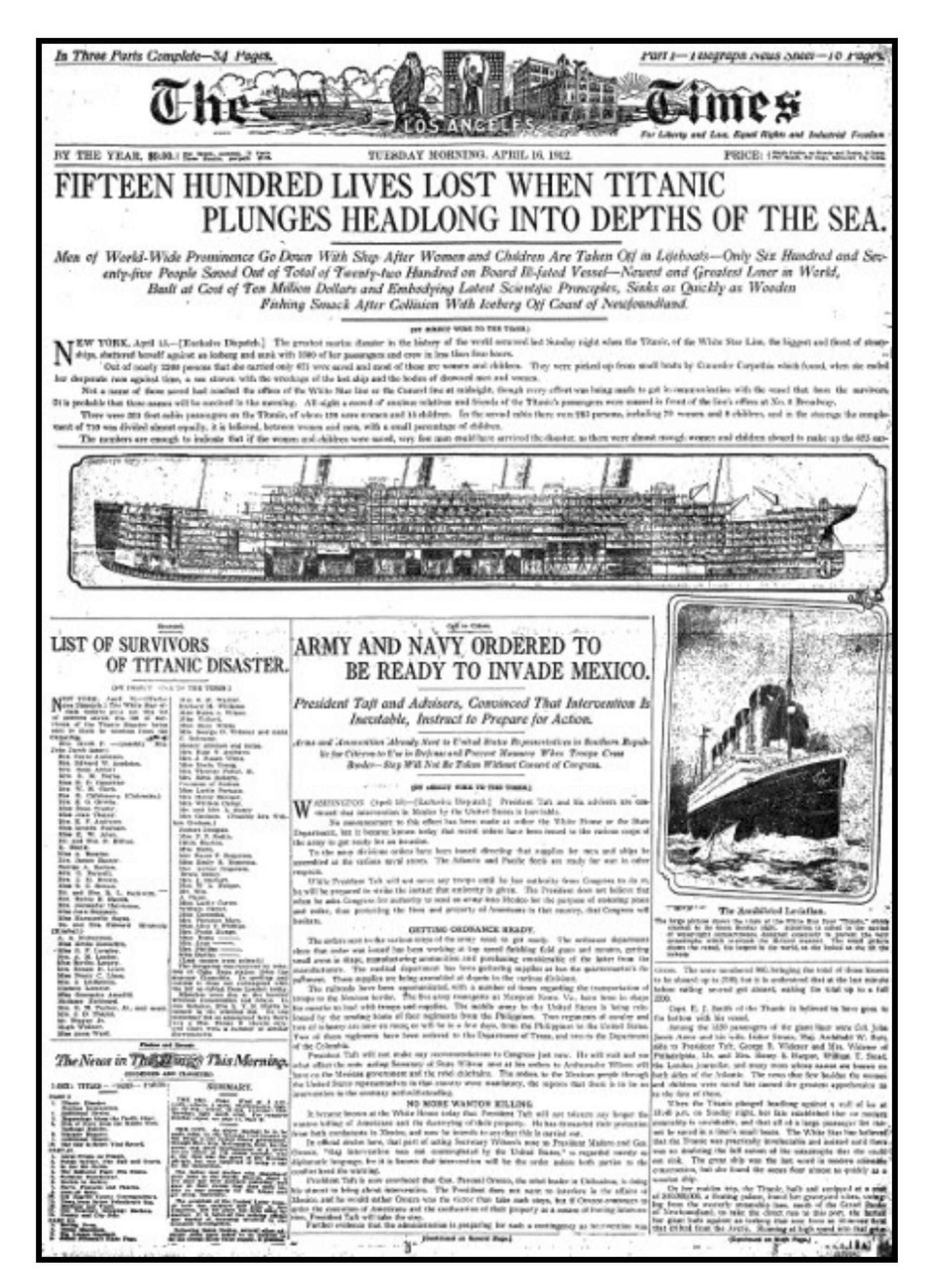
Capt. E. J. Smith of the Titanic is believed to have gone to the bottom with his vessel.
Among the 1,320 passengers of the giant liner were Col. John Jacob Astor and his wife, Isidor Straus, Maj. Archibald W. Butt, aide to President Taft, George B. Widener and Mrs. Widener of Philadelphia, Mr. and Mrs. Henry S. Harper, William T. Stead, the London journalist, and many more whose names are known on both sides of the Atlantic. The news that few besides the women and children were saved has caused the greatest apprehension to the fate of these.
When the Titanic plunged headlong against a wall of ice at 10:40 p.m. on Sunday night, her fate established that no modern steamship is unsinkable, and that all of a large passenger list cannot be saved in a liner’s small boats. The White Star line believed that the Titanic was practically invulnerable and insisted until there was no doubting the full extent of the catastrophe that she could not sink. The great ship was the last word in modern scientific construction, but she found the ocean floor almost as quickly as a wooden ship.
On her maiden trip, the Titanic, built and equipped at a cost of $10,000,000, a floating palace, found her graveyard when swinging from the westerly steamship lane, south of the Grand Banks of Newfoundland, to take the direct run to this port, she hurled her giant bulk against an iceberg that rose from an immense field that drifted from the Arctic. Running at high speed into that grim and silent enemy of seafarers, the shock crushed her bow. From a happy, comfortable vessel she was converted in a few minutes into a bedlam of misery and dreadful suffering. Through the plates and timbers water rushed so swiftly that her captain, E. J. Smith, the admiral of the White Star fleet, knew there was no hope of saving her. That much the faltering wireless had told.
Wireless tells of saving over eight hundred people
BOSTON, April 15 — A wireless message picked up late tonight, relayed from the Olympic, says that the Carpathia is on her way to New York with 866 passengers from the steamer Titanic aboard. They are mostly women and children, the message said, and it concluded:
“Grave fears are felt for the safety of the balance of the passengers and crew.”
At midnight tonight the officials of the White Star Line were struggling to get into communication with the Cunarder Carpathia, which has on board the 675 women and children saved from the Titanic, but not one word of news could they obtain. All they could get by wireless was that the Carpathia, which left New York on April 13 for the Mediterranean, was retracing her course to this port, bringing here the women and children widowed and orphaned by the disaster. The Marconi stations were striving also to get in touch with either the Carpathia or the Allan liner Virginian to find out whether all the rescued were really on board the Carpathia, or the Virginian carries others that were saved, but the Marconi people were unsuccessful and it is not known whether or not the Virginian transferred all those she picked up to the Carpathia.
The latest news is that the Carpathia had started for New York. She should reach here some time on Wednesday.
The five people aboard a submersible that vanished on a trip to explore the Titanic wreckage have died after a catastrophic implosion, the U.S. Coast Guard says.
Passengers are worth billion
- Ten men aboard Titanic have great fortunes
- Five hundred million dollars represented by few
- Astor and Bride, Guggeinheim and others in list
NEW YORK, April 15 — [Exclusive dispatch] Wealth aggregating something like half a billion dollars is represented by ten of the passengers on the Titanic. If calamity befell only a few of these ten, it would materially affect vast business enterprises in the United States and England.
Foremost among the passengers of wealth is Col. John Jacob Astor, who was returning to New York with his bride, formerly Miss Madeline Force. Col. Astor’s holdings may amount to $150,000,000. Besides attending to his realty interests he is connected with many corporations.
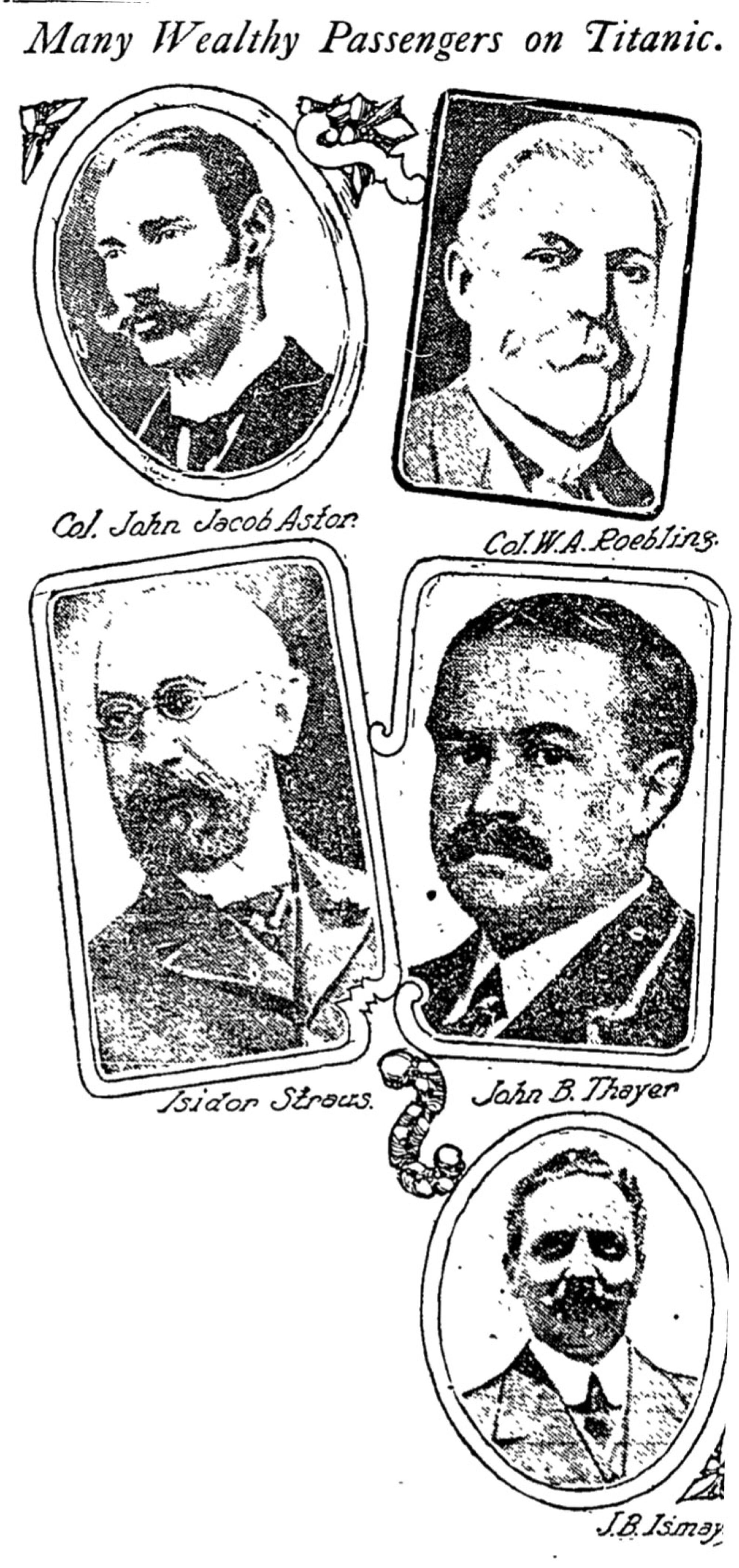
Next in financial importance come Benjamin Guggenheim and George D. Widener. Mr. Guggenheim is head of the American Smelting Securities Company, the great mining corporation, which was founded by his father, Meyer Guggenheim. He is connected with the following corporations: Blake & Knowles Steam Pump Works, president and director; the Henry R. Worthington Company, president and director; International Steam Pump Company, president and director; Power and Mining Machinery Company, president and director.
Fortunes of men aboard Titanic
Col. John Jacob Astor: $150,000,000
J. Bruce Ismay: $40,000,000
Col. Washington A. Roebling: $25,000,000
Isador Straus: $50,000,000
George D. Widener: $50,000,000
Benjamin Guggenheim: $95,000,000
J. B. Thayer: $10,000,000
—
Total: $420,000,000
George D. Widener is connected with Widener-Elkins Traction Synidicate of Philadelphia. He is one of two sons of P. A. B. Widener. George D. Widener’s fortune is estimated at $50,000,000.
Col. Washington A. Roebling, builder of the Brooklyn bridge, is president and director of the John A. Roebling’s Sons Company. His fortune amounts to about $25,000,000.
Isidor Straus is one of the best known merchants in the world, and is worth about $50,000,000. Mr.s Straus is connected with the following organizations: R. H. Macy & Co., L. Straus & Sons, Abraham & Straus, the Birbeck Investment Savings and Loan company, vice-president and trustee; The Educational Alliance, president and director, Hanover National Bank, director, Second National Bank, director.
Virginian silent on rescue work
By AP night wire to The Times
MONTREAL, April 15 — The two Allan line steamships Virginian and Parisian, which were reported as having steamed toward the scene of the Titanic’s disaster, had made no report to the company headquarters here at 10 o’clock tonight of what they had done.
Reports that the Virginian had sent a wireless saying she had rescued a number of passengers and retransferred them to the Carpathia were not confirmed.
George Hannah, general manager of the line, is of the opinion that the Virginian arrived too late to be of any assistance, and, being a mail bus, proceeded on her voyage.
She may not be in touch with the world until she nears the Irish coast.
Mr. Hannah thinks the Parisian may have arrived in time to be of assistance to the Titanic. If she did, he thinks she probably would have spent some time cruising around in search of persons clinging to wreckage and it is possible some were saved this way.
J. Bruce Ismay is president of the International Mercantile Marine Company, and is one of the founders of that big organization. It was Mr. Ismay and J. P. Morgan who consolidation American and British steamship lines. It also was Mr. Ismay who conceived the idea of building the Titanic. He is worth probably $50,000,000.
John B. Thayer is vice-president of the Pennsylvania Railroad. His son J. J. Thayer Jr., who was on the Titanic with his parents, formerly was a noted full-back on the University of Pennsylvania football team. Young Thayer was known as one of the best full-backs that ever played on a college team.
If the fortunes of all the first-class passengers were placed together, they would make easily $1,000,000,000 while the fortunes of the ten richest of them would aggregate $500,000,000.
Alfred Hagen has taken two voyages on the Titan submersible, which is now missing near the site of the Titanic shipwreck. He describes what the conditions might be like onboard.
‘Horrible loss of life,’ admit officers
By AP night wire to The Times
NEW YORK, April 15 — More than 1,500 persons, it is feared, sank to death early Sunday when, within four hours after she crashed into an iceberg, the mammoth White Star steamer Titanic from Liverpool to New York on her maiden voyage went to the bottom of Newfoundland banks. Of the 2,200 persons on board, some of them of world-wide prominence, only 675 are known to have been saved.
White Star offices in New York, while keeping hope to the last, freely admitted there had been “horrible loss of life.”
The total number on the Titanic
By direct wire to The Times
LONDON, April 15 — [Exclusive dispatch] At the White Star offices here it was said the total number of persons aboard the Titanic was 2,358, divided as follows: First cabin, 350, second cabin, 903. This differs considerably from the numbers given out in New York, adding 170 to the total.
Accepting early estimates of the fatality list as accurate, the disaster is the greatest in marine history. Nearest approaching it in magnitutde were the disasters of the steamer Atlantic in 1873, when 547 lives were lost, and the La Bourgogne in 1898, with a fatality list of 571.
Officers of the Titanic
NEW YORK, April 15 — [By AP night wire]
Officers of the Titanic were:
Capt. J. E. Smith, commander; surgeon, W. A. N. O’Laughlin; assistant surgeon, J. E. Simpson; purser, H. W. McElroy; second purser, R. L. [edit note: undecipherable], chief steward, A. Latimer.
Should it prove that other liners, notably the Allan liners Parisian and Virginian, known to have been in the vicinity of the Titanic early yesterday, had picked up other of her passengers, the extent of the calamity would be greatly reduced. This hope remains.
News of the sinking of the liner and of the terrible loss of life came early last evening with all the greater shock because hope had been buoyed up all day by reports that the steamship, although badly damaged, was not sinking, and that all her passengers had been taken off safely.
The messages were mostly unofficial, however, and none came directly from the liner, so that a fear remained of possible back news to come.
SURVIVORS PICKED UP
Shortly after 7 o’clock tonight there came flashing over the wires from Cape Race, within 400 miles of which the liner had struck the iceberg, word that at 2:20 o’clock this morning, three hours and fifty-five minutes after receiving her death blow, the Titanic had sunk. The news came from the steamer Carpathia, relayed by the White Star liner Olympic, and revealed that by the time the Carpathia, outward bound from New York, and racing for the Titanic on a wireless call, reached the scene, the doomed vessel had sunk.
Left on the surface, however, were lifeboats from the Titanic and in them it appears, according to meager reports received at a late hour, were some 675 survivors of the disaster. These, according to advices, the Carpathia picked up and is now on her way with them to New York.
For the rest, the scene as the Carpathia came up was one of desolation. All that remained of the $10,000,000 floating palace on which nearly 1,400 passengers had been voyaging luxuriously to this side of the Atlantic, were bits of wreckage. The biggest ship in the world had gone down, snuffing out in her downward plunge, it appeared, hundreds of human lives.
A significant line in the Cape Race dispatch was the announcement that of those saved by the Carpathia, nearly all were women and children. Should it prove that no other vessel picked up any passengers of the sinking liner, this might mean that few of the men had been saved, as the proportion of women and children among the passengers was large. The same facts would likewise spell the doom of practically the entire crew of 800.
In the cabins were 230 women and children, but it is not known how many there were among the 740 third-class passengers.
In the first cabin were 128 women and fifteen children, and in the second cabin, seventy-nine women and eight children.
List of survivors of Titanic disaster
Mrs. Jacob P. — (possibly Mrs. John Jacob Astor.)
Mrs. Harry Anderson
Mrs. Edward W. Appleton
Mrs. Rose Abbott
Mrs. G. M. Burns
Miss D. D. Cassebier
Mrs. W. M. Clark
Mrs. B. Chibinance (Chibnaits)
Mrs. E. G. Grosby
Miss Rose Crosby
Miss Jean Thayer
Mrs. K. F. Andrews
Miss Linette Panhart
Miss E. W. Allen
Mr. and Mrs. D. Bishop
H. Blank
Miss A. Bassine
Mrs. James Baxter
George A. Bayton
Mrs. C. Barnelli
Mrs. J. M. Brown
Miss G. C. Bowen
Mr. and Mrs. R. L. Beckwith
Mrs. Henry B. Harris
Mrs. Alexander Halverson
Miss Jean Hoppach
Miss Marguerite Bayss
Mr. and Mrs. Edward Kimberly (Kimball.)
A. A. Kennyman
Miss Emile Kenechin
Miss G. F. Longley
Mrs. A. M. Leader
Miss Bertha Lavery
Mrs. Ernest H. Lines
Miss Neary C. Lines
Mrs. J. Lindstrom
Gustave Lesneur
Miss Georgette Amadill
Madame Meliteard
Mrs. G. M. Tucker, Jr., and maid
Mrs. J. D. Thayer
Mr. Thayer, Jr.
Hugh Wollner
Miss Anna Ward
Mrs. S. M. Warner
Richard M. Williams
Miss Helen A. Wilson
Miss Willard
Miss Mary Wicks
Mrs. George D. Widener and maid
C. Rolmane
Master Allerson and nurse
Mrs. Kate T. Andrews
Mrs. J. Stuart White
Miss Maria Young
Mrs. Thomas Potter, Jr.
Mrs. Edna Roberts
Countess of Rothes
Miss Lucile Fortune
Mrs. Henry Sharper
Mrs. William Carter
Mr. and Mrs. L. Henry
Mrs. Graham. (Possibly Mrs. William Graham.)
Robert Douglas
Mrs. P. P. Smith
Hilda Slayton
Mrs. Earle
Mrs. Susan P. Rogerson
Miss Emily B. Rogerson
Mrs. Arthur Rogerson
Bruce Ismay
Mrs. J. Stewart
Mrs. W. A. Hooper
Mr. Nile
J. Flynn
Miss Lucile Carter
William Carter
Miss Cummins
Mrs. Florence Mare
Miss Alice P. Phillips
Mrs. Paula Munge
Miss Rosie —
Mrs. Jane —
Mrs. Philliso —
Miss Bertha —
(Last names were missed.)
NOTABLE PERSONS
Notable persons, travelers on the Titanic, whose fate was in doubt in the lack of definite advices as to the identity of the survivors, were: Mr. and Mrs. John Jacob Astor, Maj. Archibald W. butt, aide to President Taft, Charles M Hayes, president of Grand Trunk Pacific Railway, his wife and daughter, W. T. Stead, Benjamin Guggenheim, F. D. Millett, the artist, and G. D. Widener of Philadelphia, Mr. and Mrs. Isidor Straus, J. B. Thaver, vice-president of the Pennsylvania Railroad, J. Bruce Ismay, Henry B. Harris, the theatrical manager, and Mrs. Harris and Col. Washington A. Roebling, builder of the Brooklyn bridge.
A ray of hope appeared shortly before 11 o’clock tonight in a message to the night operator at the Marconi wireless station at Sable Island, near the scene of the disaster. Answering an inquiry regarding the delivery of wireless messages to the passengers of the Titanic, the operator reported that it was difficult to deliver them “as the passengers are believed to be dispersed among several vessels.”
Even this faint indication that other vessels than the Carpathia had picked up survivors of the Titanic was eagerly seized upon by thousands of relatives and friends of those who had set sail on her for this country.
The White Star offices had endeavored vainly from 8 o’clock until 11 p.m. to get further word from the Olympic about the Titanic. Vice-President Franklin said at 11 o’clock they were hopeful of getting another message tonight
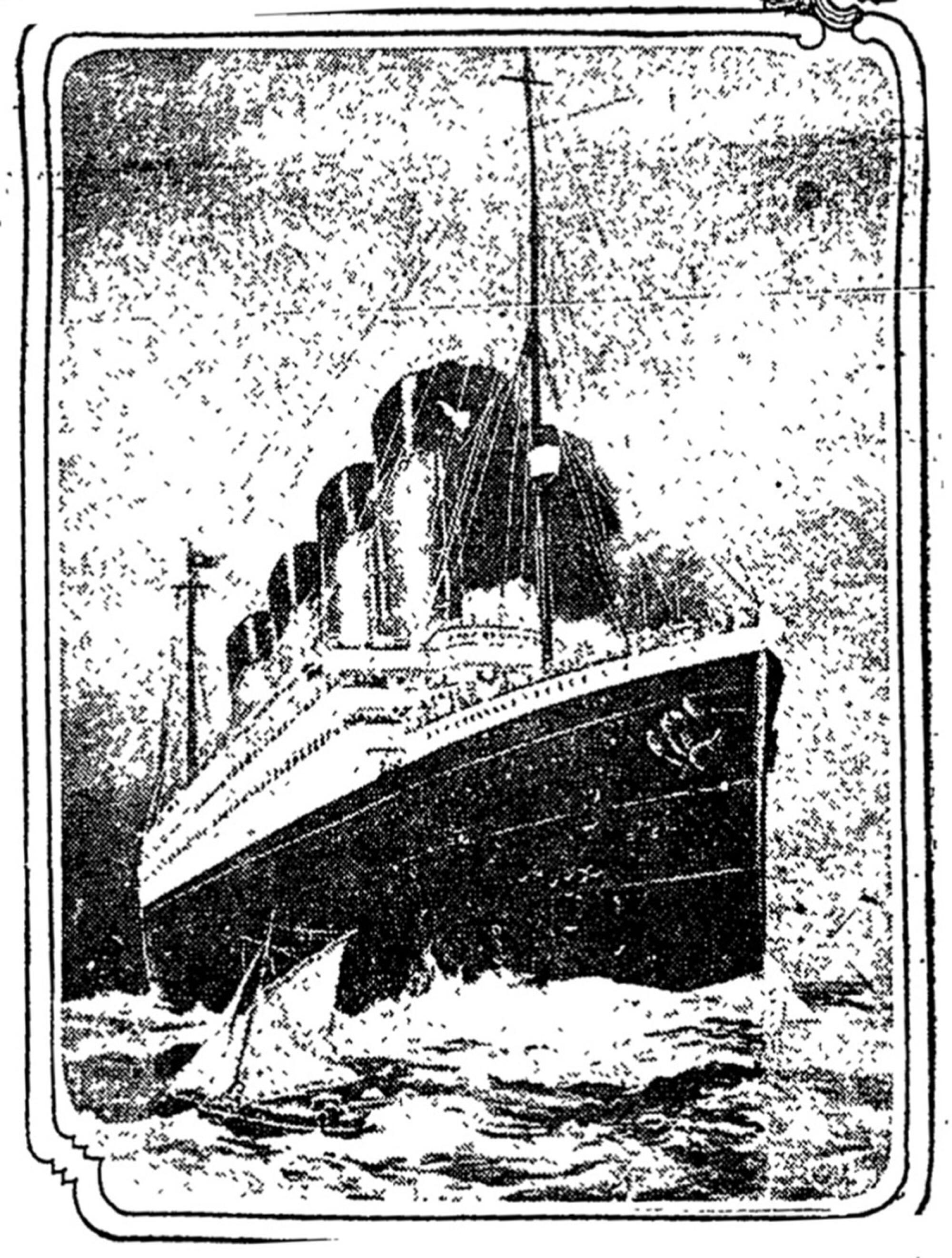
TRYING FOR LIST OF LIVING
The company was also trying to get into wireless communication with the Carpathia and filed a messaged asking that if possible the complete list of of the names of the 675 survivors said to be on board the Carpathia be sent by wireless.
Sinks two miles to the bottom
By AP Night wire to The Times
HALIFAX (N. S.) April 15 — The deathbed of the $10,000,000 steamer Titanic and of probably many who must have been dragged down with her, is two miles below the surface of the sea.
The calculation was made by an official of the government marine department, who finds that depth on the marine chart at a point of about 500 miles from Halifax and seventy miles south of the Grand Banks, where he believes the Titanic went down.
This location is midway between Sable Island and Cape Race, and in line with those dangerous sands, which however, might have proved a place of safety had there been time to run the Titanic there and beach her.
The Canadian warship Nlobe, which has one of the most powerful wireless equipments of any vessel in this vicinity, was unable to get tune with any of the ships in vicinity of the Titanic disaster, and the government station at Camperdown heard only fragmentary relays of messages.
Lloyd’s agent here had not received late tonight any official notification of the loss of the Titanic.
Such a list Vice-President Franklin believes to be of the utmost importance, as hope was waning among the White Star line officials tonight that any others than these 675 persons had survived.
Amid confusion at the offices the situation was studied as calmly as possible. Mr. Franklin figured that notwithstanding his fervent hope to the contrary the Allan line steamers Virginian and Parisian barely could have reached the scene of the disaster in time to have been of assistance. When the Virgininian first reported catching the “C.Q.D.” signal she said she was not likely to be able to reach the scene of the wreck before 10 a.m. today. That would have been nearly eight hours after the Titanic sank. It was equally doubtful if the Parisian could have reached the scene in time.
'May rescue' from Virginian
By AP night wire to The Times
LONDON, April 16 — A dispatch from St. John’s, received at 2:15 o’clock this morning, gave rise to the hope that the steamer Virginia has some of the Titanic’s survivors on board. The message said she would bring to St. John’s such survivors as she “may rescue.” Hope arises from the fact that the steamer is putting in there at all, which she would scarcely do were there not some necessity for this action. She was outward bound for liverpool.
Mr. Franklin said that from his knowledge of Capt. Smith’s gallantry and heroism on other occasions, the veteran navigator must have struck his bridge and gone down with his ship.
There was discussion as to whether all the male passengers had sacrificed opportunity to save themselves by giving women and children the first chance at the boats.
“There is no rule of the sea,” said Mr. Franklin, “which requires such sacrifice. It is a rule of courtesy on land as well as sea that gallant men have observed in time of disaster.”
The White Star officers figured from their data that the Olympic was forty miles from the scene of the Titanic’s inking when she sent the news of it at 7 o’clock tonight. At that hour the Carpathia was estimated to be 1,080 miles east of Sandy Hook.
The exploitative coverage of the death and terror unfolding in real time as the search for the Titan sub continued was compounded by the public’s reaction on TikTok and Twitter.

Exciting scenes enacted at Lloyd’s
(By AP night wire to The Times)
LONDON, April 16 — Some of the London newspapers went to press this morning under the belief that all on board the Titanic were safe, and that the vessel was proceeding for Halifax. These in editorial congratulated all concerned that man’s inventive genius had reduced the perils of a sea voyage to a minimum. Dispatches recording the sinking of the Titanic, with loss of life, appear only in the very latest editions, and the terrible extent of the disaster will not become known to the British public generally until much later in the day.
Exciting scenes were witnessed at Lloyd’s underwriting rooms yesterday. Insurance losses in the last six months have been unparalleled in the history of Lloyd’s in liners of the big class. Since the Olympic collision, both the Dehli and Oceana have been wrecked, and now comes the disaster to the Titanic. When business opened there was a rush to reinsure. Fifty guineas per cent was charged, and this rapidly rose to sixty, but later dropped to twenty-five on news that the Titanic was being towed to Halifax. It is understood there was no specie aboard the liner, but large insurance had been written on diamonds and other valuables in her cargo.
Up to 3:30 o’clock this morning the White Star officials at Liverpool had no further news concerning the Titanic. Brief wireless messages from Cape Race have been received, but are identical with those from New York.
Virtually all the Titanic’s crew belong in Southampton, where the greatest anxiety prevails as to their fate.
Interviews are published here with experts relative to the possible cause of the disaster. Considerable attention is called to the question as to whether it was possible that suction could have anything to do with it, and it is pointed out that this question came up in the inquiry into the Olympic-Hawke collision.
Loss may total eighteen hundred, says wireless
By AP night wire to The Times
NEW YORK, April 15 — The text of the message from the steamer Olympic reporting the sinking of the Titanic and the rescue of 675 survivors, which reached here late tonight, also expressed the opinion that 1,800 lives were lost.
“Loss likely total 1,800 souls,” the dispatch said in its concluding sentence
Col. Astor dead, Bradstreet's hear
By direct wire to The Times
NEW YORK, April 16 — (Tuesday.) — Col. John Jacob Astor, who recently married 18-year-old Madeline Force, was among the passengers who went down with the ill-fated Titanic, according to a wireless dispatch received by Bradstreet’s from the liner Olympic.
The dispatch further states that Mrs. Astor was saved and is being brought to shore by the Carpathia.
The message received by Bradstreet’s also confirms the terrific loss of life on the Titanic and declares that those picked up by the Carpathia were the only ones saved.
The list as given out showed 1,310 passengers and a crew of 860 or 2,170 persons in all. The wireless message later picked up at Boston reports 866 known to have been rescued, leaving 1,304 unaccounted for.
The Olympic’s dispatch follows:
“Carpathia reached Titanic position at daybreak. Found boats and wreckage only. Titanic sank about 2:40 a.m. in 41:16 N., 5° 14 W. All her boats accounted for containing about 675 souls saved, crew and passengers included. Nearly all saved women and children. Leyland liner Californian remained and searching exact position of disaster. Loss likely total 1,800 souls.”
More to Read
About this story from the archives
